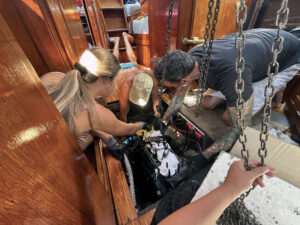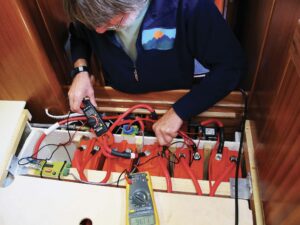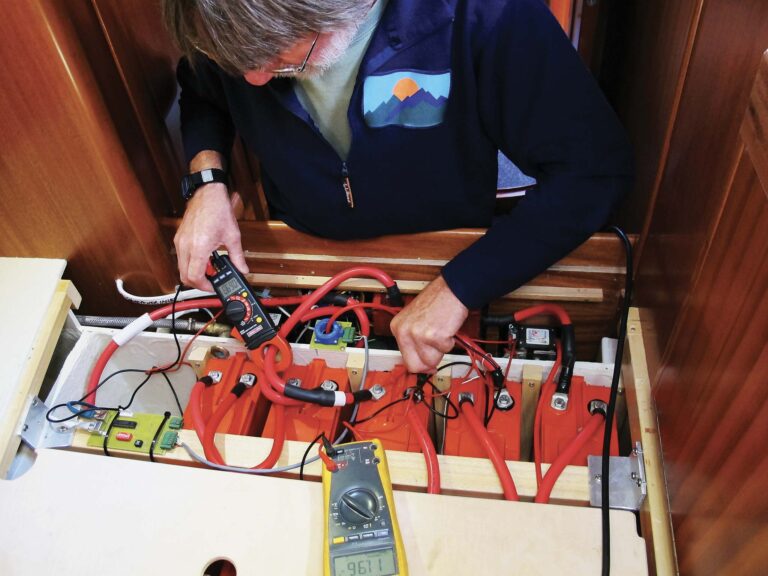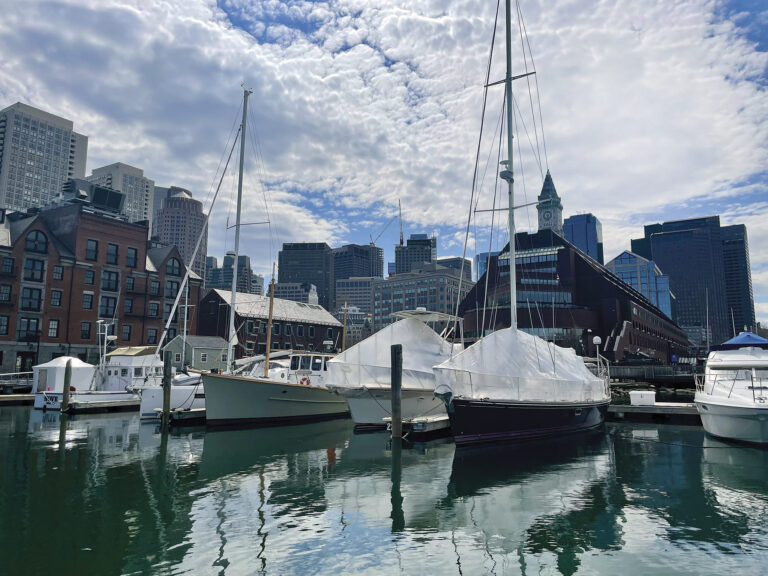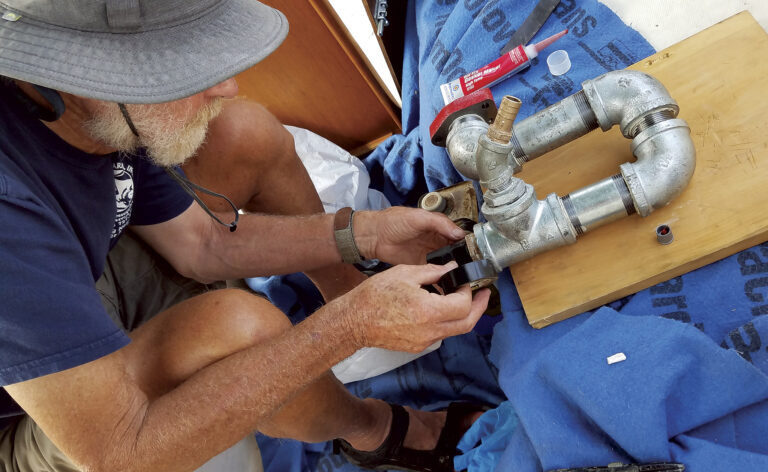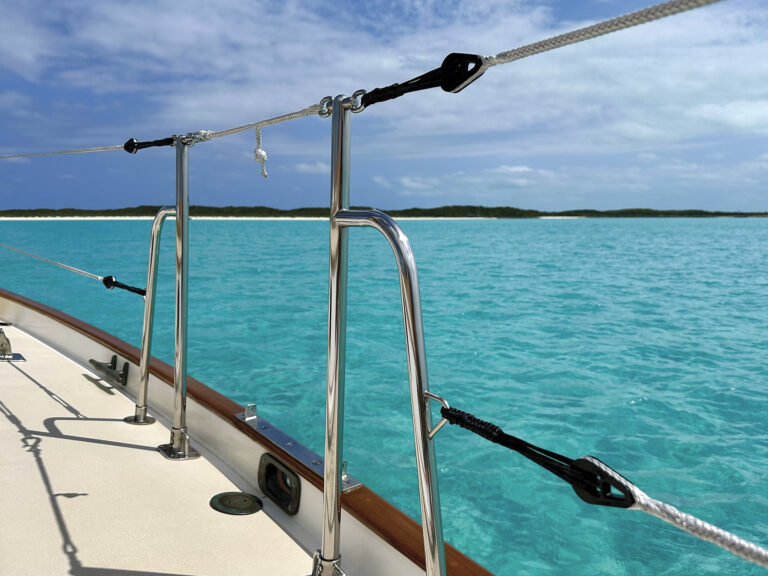Don’t be lulled into taking your boat’s underbody for granted
This is NOT a Chicken Little article. While it’s true that it is exceedingly rare for a keel to separate suddenly from its hull (radical race boats aside), cases of keels separating slowly from their hulls are more common than you might think.
Encapsulated Ballast
When ballast is inside a hull, the only way it will leave the boat is if you tear the bottom out. This is reassuring, but this does not mean that an encapsulated keel doesn’t need inspecting.
If, for example, the ballast is iron and water finds its way into the cavity, the iron will begin to “grow” rust, which can distort or split the encapsulating laminate.
Similarly, on a winter-stored boat with iron or lead ballast, water inside the cavity will freeze, exerting destructive pressure on the fiberglass. Encapsulated keels should be regularly inspected for skin damage, swelling and weeping. Investigate any rusty discoloration. Check also the seal of the fiberglass cap over the ballast.
Bolt-on Keels
Keels that bolt in place provide some design advantages, but they are also more troublesome. Let’s start with the joint between the keel and the hull or keel stub.
If the bottom of the boat is painted, this joint should be invisible; a crack in the paint tells you the keel is moving. A hairline crack is quite normal, because keels are often bedded with flexible sealant, but the wider the crack, the greater the risk that water has penetrated the joint. It is a good practice to inspect the keel joint while the boat is in its slings, as this can reveal a separation that closes as soon as the keel is bearing weight.
It is not a good sign if a keel joint does not dry immediately after haul-out. If your keel exhibits what is known as a “smile,” with rust stains running down from the joint (an ironic analogy, to be sure), water is probably reaching some, or all, of the keel bolts. Rust stains on a lead keel are a sure sign of corroding bolts. On an iron keel, the pattern of rust staining will indicate whether the problem is with the keel or bolts, with the smile being broader and more continuous if it is the keel.
Perhaps the warning sign that is hardest to dismiss is unexplained water in the bilge. Even if the bilge is dry, discoloration or distortion of one or more of the resin caps covering the keel bolts can be a reliable sign of water penetration. Chipping off a cap or two to get a look at the inboard ends of the bolts will either reassure or worry you.
Note that keel bolts almost invariably appear to be studs. They might be studs, threaded into a tapped hole in an iron keel, or J bolts (just what they sound like) cast into a lead keel. They can also be long bolts inserted from the bottom of the keel, or short ones that only extend through a flange at the top. Sometimes keel bolts are threaded around stock, captured at the lower end with a nut fitted through a side-opening recess in the keel.
Bolt Materials
Bronze: If you are fortunate enough to have bronze keel bolts, a leaking keel joint poses little risk to their integrity. Just make sure the keel is lead, as bronze bolts paired with a cast-iron keel will create a galvanic reaction. Barring unusual circumstances, bronze keel bolts are good for the life of the boat. Their one susceptibility is to over-tightening, so never exceed the torque specification for the diameter of the bolt.
Mild steel: It can come as a shock to learn that the keel bolts on your particular boat are galvanized steel. Mild steel bolts are used not because they are cheap, but because they are more galvanically compatible with cast iron than stainless steel or bronze. Unfortunately, they also have a shorter life expectancy. Galvanized keel bolts more than 15 years old are past due for inspection.
If the keel is iron, an in situ X-ray inspection is possible but costly and often difficult to arrange. Ultrasonic testing is often cited as another possibility, but the exacting requirements for a reliable result are difficult or impossible to meet on site. This usually makes withdrawing the bolts the only practical option, which takes us to a second shortcoming of galvanized bolts: they have a penchant for seizing with rust. This can make inspecting even a single bolt a very big job.
The forwardmost bolt is often shorter, thus easier to extract, but the main reason to choose it for initial inspection is that, as evidenced by many “smiles,” keel joints tend to open at the forward end first. If the seal has failed, the forward bolt likely will have had the longest exposure to seawater. A sound first bolt does not guarantee that the others are in equally good shape, but it does offer some assurance.
The cost of inspection will be in the labor, so unless an extracted bolt is absolutely pristine, replace it with a new one. If a test bolt shows serious corrosion, you should replace all the bolts securing your keel.
Stainless steel: The most common keel-bolt material in America is stainless steel. This is dismaying to many, because stainless steel suffers rampant corrosion when immersed in stagnant seawater. Using it for keel bolts anticipates that the bolts will remain dry—which is optimism bordering on delusion. The good news is that if they do remain dry, they have proven to last for half a century or longer.
The tops of stainless steel keel bolts are almost always encapsulated with resin to protect them from bilge water. Chip off a cap, and you are likely to find a mild steel washer beneath the stainless steel nut. This practice leads to loosening of the keel attachment when such washers lose thickness to rust, but it also provides durable evidence of water intrusion. If the washer and/or backing plate are not sitting on a bed of sealant, an absence of rust is a positive sign for the health of the bolt beneath.
In an iron keel, stainless keel bolts enjoy the advantage of being easier to extract. This is because the galvanic action between the steel and less noble iron enlarges the hole in the iron over time, causing the threads tapped into the iron to be reduced in size and strength. To mitigate this interaction, stainless bolts are typically coated with some kind of an insulating substance. However, these coatings tend to scuff away during insertion, which limits their effectiveness, so they merely slow the pace of the interaction and don’t eliminate it.
Lead is too malleable for threads, so typically stainless steel J-shaped bolts are cast into a lead keel. Because these cannot be extracted, the only way to inspect them is to separate the keel from the hull. The worst corrosion damage to stainless steel keel bolts invariably occurs just above the top of the keel, where the bolts have been encased by the stub or the hull, so lowering the keel or raising the hull just enough to get a look at the bolts in this location can be sufficient to confirm or dispel concerns about bolt integrity.
Hull Issues
A pronounced smile might have less to do with the keel than with the hull. Lightly built boats may not be strong or stiff enough to resist the constant compression and/or prying force of the keel where it is attached. Similarly, grid structures can fracture or become unbonded, or a wood core in the keel stub (an egregious design error) can lose all compression strength when water penetrates the joint.
Be aware that damage from grounding, typically confined to the points of impact on an encapsulated keel, can apply off-the-scale forces to the hull when the keel is bolted on. A hard grounding or other impact drives the rear of the keel upward into the boat while at the same time prying violently down at the front. Common consequences are fractured or loosened grid structures; cracked, warped, or unbonded pans or furniture; torn floor bonds; separated bulkhead bonds; a displaced mast step; a dimpled, broken, or torn hull behind the keel; and delamination forward of it.
If you suspect impact damage, spend an hour inspecting the area around the keel, both inside and outside, assisted by a bright light, a small mirror and a flexible blade. Outside, use the light at low angles to reveal bumps or dips in the hull and at full intensity to expose cracks or tears. Inside, check grid structures and interior pans for cracks, using a mirror to view all sides. Probe all grid, pan, floor, step, and bulkhead bonds with your flexible blade.
Should your inspection reveal hull damage or weakness, you’ll need to deal with this first. Corrective measures depend entirely on the problem, but if the damage is serious, you will probably have to remove the keel. In addition to grinding away and replacing any fractured or delaminated glass, a full repair will also necessitate additional reinforcing members and/or additional layers of fiberglass to strengthen the damaged areas.
Still Smiling
When faced with a visible crack at the keel joint, many owners will simply fill and fair it with caulk or epoxy and then cover it with bottom paint. This is easy, inexpensive and does no harm, but ignores the possibility that the crack may be a sign of a more serious underlying structural problem.
Retorquing the keel bolts, particularly the forward ones, is another common response. Retorquing might close the smile, and may even stem a keel-bolt leak, but it still fails to address the possibility that serious damage has already occurred. Indeed, trapping stagnant seawater around stainless steel bolts is sure to foster pitting, a particularly virulent form of corrosion. Retorquing also carries the real risk of shearing one or more of the bolts (an unhappy event that might be viewed as fortunate in the long run).
If your keel is iron with galvanized bolts that have not been inspected in the last five years, the best response to an opening keel joint is to extract a bolt or two for inspection. This should not be difficult with a flanged keel. However, if the bolts pass up from the bottom, and particularly if they are threaded into the keel, the likely difficulty and/or cost to extract even one bolt could lead you to opt for retorquing, waiting on a sheared bolt to give this job undeniable urgency.
That said, for real confidence in the keel attachment, a visual inspection of a different bolt or two every five years is essential for galvanized keel bolts that have been in service 15 years or more.
If your iron keel has stainless steel bolts, extract the front one. If it is sound, you can retorque it and the rest of the bolts with some confidence that the opening joint is due to some reshaping of the laminate under compression.
With a lead keel, extracting a single bolt is not an option. If you see no signs of water reaching the bolts—which are often protected by seals around them—then the corrective action is just to retorque the bolts. In addition to the plasticity of the fiberglass, the lead can be sufficiently malleable to allow some upward movement of the J bolt within the casting. Retorquing should close the gap.
If water penetration is evident in the form of rust stains or a leak, any attempt to reseal the joint by torquing the bolts is ill-advised. The cathodic coating of chromium oxide on stainless steel that regenerates when oxygen is present instead breaks down when a bolt is immersed in stagnant seawater and is deprived of oxygen. The exposed steel then becomes an anode to its own cathodic surface, like the zinc on your prop shaft, and the result is a type of corrosion that can propagate with astonishing speed. If you believe your stainless steel keel bolts have been wet for some time, you must assume they are corroding.
The good news is that most keel attachments follow a design rule that delivers a huge safety factor, so rust stains do not signify imminent failure. However, it’s important to remember that stainless steel keel bolts will continue to corrode until you can both dry and seal them. The only certain way to do that is to drop the keel, or at least to separate it from the hull far enough to allow drying and rebedding.
Replace or Supplement
If you go to the effort of separating your hull and keel, and discover serious corrosion, you are faced with hard choices. Because the bolts in a lead keel are cast in place, replacing them typically requires casting a new keel. You might also investigate shipping your old keel to Mars Metal Company in Ontario, a keel fabricator that has developed a method of removing and replacing J-bolts. Neither option will be inexpensive.
Sistering, the installation of new bolts alongside the old ones, can be a more affordable response. Whether this is an option for your boat will depend on how the hull is reinforced for the keel. A keel stub will likely offer ample strong locations for additional bolts while a reinforcing grid in the bilge may have few if any suitable locations. If your hull can accommodate additional keel bolts, perhaps with some additional reinforcement, installation is relatively straightforward (see sidebar).
A boatowner might also opt for sistering as a first step to avoid dropping the keel. In this case, because the new bolt(s) will not be positively sealed at the keel joint, they should be fabricated from an austenitic grade of stainless steel, such as Aquamet 22 or Aqualoy 22, both widely used for prop shafts. These alloys are much less susceptible to pitting or crevice corrosion in an oxygen-starved environment, with the added assurance of delivering nearly twice the tensile and yield strength of 316 stainless steel.
Shutting the Door
If you do separate keel and boat, it is essential to perfect their mating surfaces if you want to keep the bolts dry. This starts with removing all traces of old sealant, then grinding away any high spots on the hull or stub and on the top of the keel. Don’t bed the keel on a flexible sealant, even if that is how it was installed before. To prevent the keel from moving and reopening the joint, it must sit solidly against the hull.
With both surfaces prepared and the hull ready to be lowered onto the keel, put a thick bead of polyurethane sealant (3M 5200) around each of the bolts where they exit the keel. (If you have had hull and keel completely separated, chamfering the bottom of the holes in the hull will yield a more durable seal from the sealant.)
Using colloidal silica as the filler, make up enough epoxy paste to a peanut butter consistency to spread an even layer over the entire keel top, leaving an uncoated circle around each bolt for the sealant to squeeze out into. Lower the hull onto the keel and install the backing plates, washers, and nuts, using an anti-seize compound on the threads. Do not use any sealant under the backing plate so any future leak at the joint can announce itself. Torque to around 80 percent of the final value. Fair the joint with the epoxy that squeezes out, removing all excess.
After the epoxy has cured completely, tighten the keel bolts to their full torque values. Unless anti-seize was used originally–highly doubtful–torque to 55 percent of the manufacturer’s specification. (Note that recommended keel bolt torque values vary wildly. In the absence of a published number from your boat’s builder, you can use the following anti-seize-adjusted values: 1/2”-25 ft.-lb.; 3/4”-75 ft.-lb.; 1”-150 ft.-lb.; 1-1/4”-300 ft.-lb.)
Finish the job by cleaning and scuffing the fiberglass around the bolts inside and sealing each one under a resin cap. Coating each bolt with a bit of wax before sheathing will make future inspection easier.
If you choose not to repair or replace, at least monitor. Modern keel attachments are robust, but they are not immortal.
SISTER ACT
Sistering: In an iron keel, sistering is typically a matter of drilling and tapping the cast iron and threading in a new bolt. Lead is too soft for threaded attachment, so an alternative method is required to secure the bolt inside the keel.
With the keel in place, drill down from inside the boat. To assure that your new hole is not going to hit anything but lead, it is a good idea to try to obtain a manufacturer’s drawing of the keel that shows the orientation of the existing J-bolts and any other structure that may be inside the casting. Failing that, position your new hole away from any existing bolts.
The new hole should extend about 12 inches into the lead. Fill it with fresh water. Use a battery-powered drill and an 1/8-inch bit to drill into the side of the keel where you expect the down hole to be. If you hit it, water will trickle out. If not, move to one side or the other less than the down-hole diameter and drill again. Keep moving and drilling until you find water. These small holes do not compromise the keel and most will fall inside the recess to be cut.
With the down hole located, use a spade bit to cut a round window into and a little beyond it from the side, then square the top of the recess with a chisel. Your new bolt will be round stock threaded on both ends and inserted from the top. Fabricate a thick stainless steel backing plate to fit the top of your recess, above a washer and nut. To seal the bolt inside the recess, encircle it with polyurethane caulk above the backing plate before tightening. A backing plate, washer, and nut at the top completes the installation. Someone must hold the bottom nut with a wrench while the top one is taken to full torque.
When the bolt is tight, fill the window flush with epoxy paste. To improve the chances of keeping water away from the bolt, first paint the interior of the recess with unthickened epoxy, then vigorously wire-brush the wet surfaces to expose fresh lead to the epoxy without exposing it to the air. Allow this coating to stiffen, then fill the recess with the paste and tape stiff plastic over the opening to prevent sagging.
LEAK CHECK
Tip: To make sure water inside the boat is not leaking into the ballast cavity or down through the keel bolt holes, disable the bilge pump, then fill the bilge with several inches of water. You need enough to submerge the top edge of fiberglass fabric that turns up onto the interior of the hull and/or to top the keel bolts. At the same time place a straight-sided glass jar in the bilge and fill it even with the surrounding water level. Now wait a couple of days and check the level. It will be lower due to evaporation, but if the level outside the glass jar is lower than that inside the jar, the water has leaked from the bilge into the cavity or around the bolts.
Don Casey has written many books and
articles on marine maintenance and repairs


